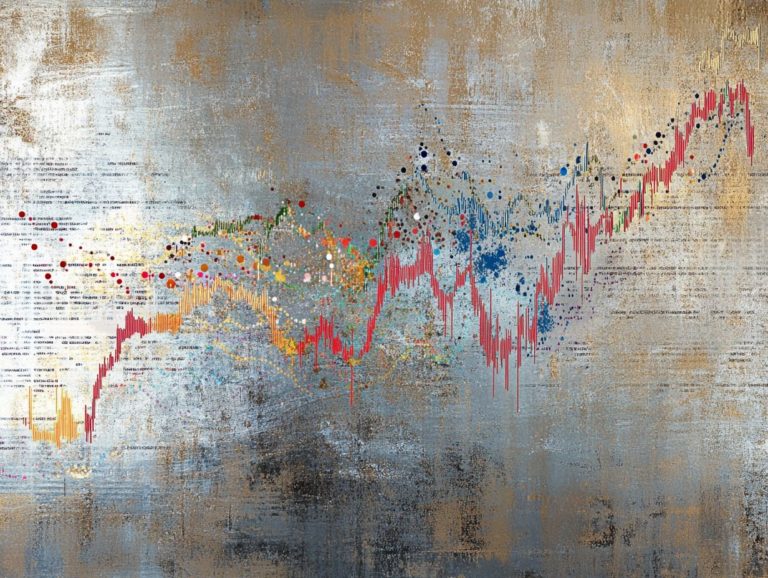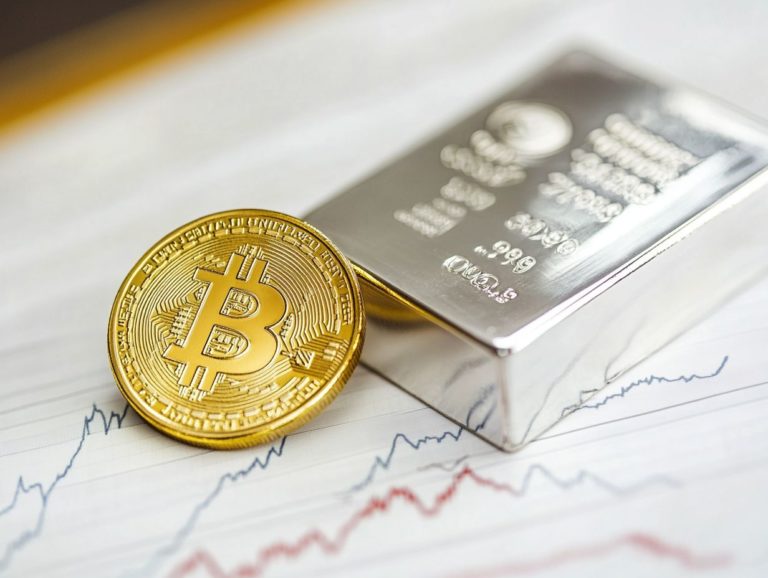How to Understand Gold and Silver Ratios?
Gold and silver ratios serve as essential tools in your investment arsenal, offering valuable insights into the relative worth of these precious metals. To truly comprehend these ratios, it’s vital to appreciate their historical significance and their current relevance within the ever-evolving market landscape. This guide will walk you through the process of calculating these ratios and interpreting their implications. You’ll discover how economic factors shape these figures and uncover strategies for integrating this knowledge into your investment decisions.
Contents
Key Takeaways:

Gold and silver ratios indicate the relative value of gold and silver in the market.
Understanding these ratios can provide insight into economic trends and help with investment decisions.
The ratio is affected by various factors such as supply and demand, economic conditions, and market sentiment.
What are Gold and Silver Ratios?
Gold and silver ratios capture the relative value of gold compared to silver, expressed as how many ounces of silver equal one ounce of gold. This pivotal metric is essential for you as an investor, aiding in your decision-making within the precious metals market. It reflects not only market forces but also historical averages and the economic dynamics that influence price fluctuations.
To calculate this ratio, simply divide the current price of gold by the current price of silver. This straightforward calculation provides a clear perspective on how these two metals stack up against each other, especially if you’re considering investing in them. For those interested in acquiring gold, it’s useful to know what are the best places to buy physical gold.
Grasping this ratio is paramount; it enables you to assess market sentiment, demand, and supply imbalances. For example, during periods of heightened volatility, an increasing gold-to-silver ratio may signal that investors are gravitating toward gold for safety amid economic uncertainty. To ensure your investments remain secure, it’s important to understand how to protect your gold investments.
A declining ratio might suggest a growing demand for silver, potentially hinting at a shift in market trends. You can sharpen your strategies by diligently monitoring these ratios and enhance the resilience of your investment decisions.
Why are Gold and Silver Ratios Important?
Understanding gold and silver ratios can significantly boost your investment strategy! These ratios offer valuable insights into market dynamics and trading opportunities that can pave the way for significant profit, especially during economic downturns and periods of volatility.
By skillfully analyzing these ratios, you can make informed financial decisions that not only align with your risk management strategies but also support the overarching goals of your investment portfolio.
Historical Significance and Current Relevance
The historical significance of the gold-silver ratio can be traced back to ancient civilizations, including the Roman Empire, where it served as a crucial barometer of monetary stability and economic prosperity. This ratio influenced trading strategies and investment decisions, a legacy that still resonates in today s financial landscape.
Its current relevance is amplified as you harness historical price data to forecast future fluctuations, making it an essential tool for analyzing recent market trends and economic downturns.
Throughout history, the relationship between gold and silver has evolved, mirroring broader economic conditions and shifts in supply and demand dynamics. This intricate interplay has forged a framework for understanding risk, reward, and value in modern finance. By examining these historical trends, you can identify patterns that shed light on how current economic indicators such as inflation rates and geopolitical tensions impact the stability of these precious metals. Additionally, understanding how to use gold to diversify your portfolio can further enhance your investment strategy.
By recognizing these correlations, you enable yourself to make more informed trading decisions, adapting your strategies to navigate a continuously evolving market landscape. Start monitoring these ratios today to make informed investment choices!
Calculating Gold and Silver Ratios

Calculating the gold and silver ratios is a simple yet effective process that involves dividing the current price of gold by the price of silver. This yields a ratio that savvy traders and investors can use to assess relative value. This process enables informed decisions within the gold and silver market.
By incorporating this calculation alongside tools used to analyze market trends and a keen analysis of market dynamics, you can uncover potential trading opportunities in both gold and silver.
Methods and Formulas
You can utilize various methods and formulas to calculate gold-silver ratios. Each offers distinct insights for your investment or trading endeavors in the gold and silver market. These techniques are crucial for crafting effective trading strategies and grasping the nuances of trading psychology.
A common method involves taking the current price of gold and dividing it by the current price of silver. This simple calculation yields a ratio that helps gauge the relative value of these two metals. Enhancing this straightforward calculation with historical data analysis allows you to identify patterns and anomalies that inform your decisions on when to buy gold.
Another approach is using moving averages. This technique helps smooth out price fluctuations and provides a clearer view of trends over time. Knowing these ratios helps you make informed trading decisions and reflects prevailing market sentiment. It serves as a valuable tool for anticipating price movements in an ever-evolving landscape.
Interpreting Gold and Silver Ratios
Interpreting gold and silver ratios requires a thorough grasp of price fluctuations and their implications for relative value in the gold and silver market. By assessing these ratios, you can make more informed trading decisions and craft strategies that leverage the distinctive characteristics of both gold and silver. This alignment allows your investments to sync with current market trends.
What Do the Numbers Mean?
The ratios derived from gold and silver reveal the intricate relationship between these precious metals. This insight provides vital information into market dynamics and potential investment opportunities. Understanding these figures enables you to develop effective trading strategies that adapt to market forces, ultimately leading to informed financial decisions.
For example, a high gold-to-silver ratio may suggest that gold is overvalued compared to silver. In this scenario, consider selling your gold investments profitably and purchasing silver to take advantage of evolving market dynamics. Conversely, a lower ratio could indicate that silver is gaining traction, encouraging you to explore opportunities in silver futures or mining stocks.
By closely monitoring these ratio values, you can formulate strategies that optimize your portfolio and minimize risk. This enhances your potential for long-term success in the ever-changing landscape of precious metals.
Factors Affecting Gold and Silver Ratios

Various factors shape the ratios between gold and silver. These include economic influences like inflation rates, market dynamics, industrial demand, and global economic trends.
These elements are pivotal in determining the relative value of gold and silver, ultimately guiding your trading strategies and investment decisions in the gold and silver market.
Economic and Market Influences
Economic influences and market forces, such as inflation rates and currency fluctuations, significantly shape the gold and silver ratios, offering you invaluable insights as you navigate investment decisions in uncertain financial climates. Grasping these relationships is crucial for making informed trading choices that resonate with current economic conditions.
When global economies experience shifts, the prices of precious metals can become quite volatile, affecting how you perceive risk and allocate your assets. For example, during periods of increased inflation, you might notice a surge in gold demand as it serves as a hedge against currency depreciation, which in turn influences the gold-to-silver ratio. Geopolitical tensions can introduce additional market fluctuations, compelling you to adjust your strategies thoughtfully.
By diligently monitoring these economic indicators and their effects, you can optimize your portfolio, positioning yourself to seize potential profit opportunities within the precious metals market.
Using Gold and Silver Ratios in Investing
Utilizing gold and silver ratios in your investment strategy elevates your decision-making process. This method enables you to evaluate relative value and uncover profitable trading strategies, particularly in volatile markets.
It plays a crucial role in effective portfolio diversification and risk management, equipping you to steer through economic downturns while seizing valuable trading opportunities.
Strategies and Tips
Developing effective strategies and tips for utilizing gold and silver ratios can significantly enhance your trading psychology and investment outcomes, especially in the face of fluctuating market conditions. These strategies are essential for improving your portfolio diversification and navigating the complexities of commodity markets.
By closely monitoring the historical relationship between these precious metals, you can gain valuable insights into potential price movements, leading to more knowledge-based decision making. One actionable approach is to establish a threshold for the gold-to-silver ratio that triggers your entry or exit points, allowing you to take advantage of market inefficiencies. For those interested in getting started, learning how to invest in gold can be a great first step.
Understanding how these ratios respond to macroeconomic indicators can also help you manage psychological biases during volatile periods, promoting a disciplined investment strategy. Embracing these methods not only refines your trading tactics but also fosters a more robust investment philosophy centered around risk management and strategic allocation.
Frequently Asked Questions

What are Gold and Silver Ratios?
Gold and Silver Ratios are a comparison of the prices of gold and silver. It is used to determine the value of gold in relation to silver and helps investors make decisions on which metal to invest in.
How is the Gold and Silver Ratio Calculated?
The Gold and Silver Ratio is calculated by dividing the current price of gold by the current price of silver. For example, if gold is priced at $1,500 per ounce and silver is priced at $25 per ounce, the ratio would be 60 (1,500/25 = 60).
Why is Understanding Gold and Silver Ratios Important?
Understanding Gold and Silver Ratios can help investors make informed decisions when buying or selling these precious metals. It can also provide insight into market trends and possible economic changes.
What is a Normal Gold and Silver Ratio?
A normal gold and silver ratio is typically around 60:1, meaning it takes 60 ounces of silver to buy one ounce of gold. However, this ratio can vary depending on market conditions and can range from 20:1 to 100:1.
How Do Changes in Gold and Silver Ratios Affect Investments?
Changes in Gold and Silver Ratios can affect investments in both metals. For example, if the ratio increases, it may be a sign to sell gold and buy silver, and vice versa. Understanding these changes can help investors make profitable decisions.
Can Gold and Silver Ratios Predict Market Trends?
While Gold and Silver Ratios can provide insight into market trends, they should not be relied upon as the sole predictor. Other factors such as economic and political changes can also influence the prices of these metals.













